New Delhi, In a significant move, RBI Governor Shaktikanata Das provided detailed insights into key decisions regarding the Unified Payments Interface (UPI). These pivotal changes include a substantial increase in the UPI payment limit for specific sectors and a noteworthy augmentation in the e-mandate limit for recurring payments.
Enhanced UPI Limits:
Governor Das, during the announcement of the bi-monthly monetary policy, disclosed a noteworthy revision in the UPI payment limit, specifically targeting transactions related to hospitals and educational institutions. The limit has been elevated from the existing ₹1 lakh to a substantial ₹5 lakh per transaction. This adjustment is expected to empower users, allowing them to conduct higher-value UPI transactions, particularly in crucial sectors such as education and halthcare.
The UPI, recognized as India’s robust mobile-based fast payment system, operates through Virtual Payment Address (VPA), facilitating instantaneous, round-the-clock payments.
E-Mandate Limit Advancements:
In another crucial development, the central bank declared a significant enhancement in the limit under e-mandates for recurring payments. The limit has been substantially increased from ₹15,000 to ₹1 lakh per transaction. Governor Das emphasized that this adjustment is particularly beneficial for individuals engaged in recurring payments for mutual fund subscriptions, insurance premium subscriptions, and credit card repayments.
Governor Das noted that the revised e-mandate limit aligns with the current framework, where an additional factor of authentication (AFA) is required for recurring transactions exceeding ₹15,000. This alteration is poised to further stimulate the usage of e-mandates, streamlining transactions of a recurring nature.
These comprehensive changes come against the backdrop of the Monetary Policy Committee’s decision to maintain the key repo rate unchanged for the fifth consecutive time.




